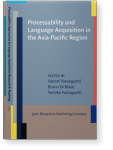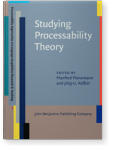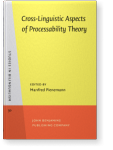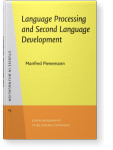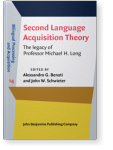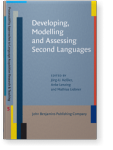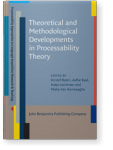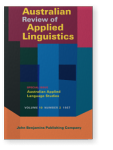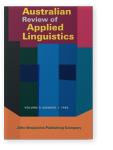Manfred Pienemann
List of John Benjamins publications for which Manfred Pienemann plays a role.
Book series
Titles
Studying Processability Theory: An Introductory Textbook
Edited by Manfred Pienemann and Jörg-U. Keßler
[Processability Approaches to Language Acquisition Research & Teaching, 1] 2011. xi, 179 pp.
Subjects Language acquisition | Psycholinguistics | Theoretical linguistics
Cross-Linguistic Aspects of Processability Theory
Edited by Manfred Pienemann
[Studies in Bilingualism, 30] 2005. xiv, 303 pp.
Subjects Language acquisition | Multilingualism | Psycholinguistics
Language Processing and Second Language Development: Processability theory
Manfred Pienemann
[Studies in Bilingualism, 15] 1998. xviii, 366 pp.
Subjects Multilingualism
2022 Chapter 3. Stabilization: A dynamic account Second Language Acquisition Theory: The legacy of Professor Michael H. Long, Benati, Alessandro G. and John W. Schwieter (eds.), pp. 29–76 | Chapter
We accord with Mike Long’s rejection of fossilization as a concept able to describe or explain second language acquisition. And we share his bewilderment (Long, 2003, p. 512f.) that since most studies of fossilization make reference to explanatory factors external to language and cognition,… read more
2016 Testing the Developmentally Moderated Transfer Hypothesis: The initial state and the role of the L2 in L3 acquisition* Developing, Modelling and Assessing Second Languages, Keßler, Jörg-U., Anke Lenzing and Mathias Liebner (eds.), pp. 79–98 | Article
This paper focuses on one specific aspect of the Developmentally Moderated Transfer Hypothesis (Pienemann et al. 2005), namely the role of the L2 in L3 acquisition. The research presented in this paper was prompted by the L2 transfer hypothesis put forward by Bohnacker (2006) and Bardel and Falk… read more
2015 Chapter 5. Response Paper: Exploring the Interface between Morpho-Syntax and Discourse/Pragmatics/Semantics Theoretical and Methodological Developments in Processability Theory, Baten, Kristof, Aafke Buyl, Katja Lochtman and Mieke Van Herreweghe (eds.), pp. 105–112 | Article
2011 Research methodology: How do we know about developmental schedules? Studying Processability Theory: An Introductory Textbook, Pienemann, Manfred and Jörg-U. Keßler (eds.), pp. 84–96 | Article
PT-based studies make testable claims about language acquisition. Any study of language acquisition that makes testable claims needs to be based on observations of the acquisition process. One major method of observation (used both in research on child language as well as second language… read more
2011 Explaining learner variation Studying Processability Theory: An Introductory Textbook, Pienemann, Manfred and Jörg-U. Keßler (eds.), pp. 64–74 | Article
The objective of this chapter is to explain learner variation as described in Chapter 2 using the processability framework outlined in Chapters 3 and 4. We will focus on two aspects: (1) the limited structural range within which interlanguage variation occurs and (2) the steadiness of learner… read more
2011 Explaining developmental schedules Studying Processability Theory: An Introductory Textbook, Pienemann, Manfred and Jörg-U. Keßler (eds.), pp. 50–63 | Article
The objective of this chapter is to explain the developmental schedule described in Chapter 1 using the processability framework outlined in Chapter 3. For this purpose, we will first look at a summary of the developmental schedule for ESL acquisition. Then two empirical studies supporting this… read more
2011 L1 transfer Studying Processability Theory: An Introductory Textbook, Pienemann, Manfred and Jörg-U. Keßler (eds.), pp. 75–82 | Article
This chapter focuses on the role of transfer in Processability Theory which is encapsulated in the “Developmentally Moderated Transfer Hypothesis” (Pienemann 1998; Pienemann, Di Biase, Kawaguchi & Håkansson 2005). The chapter is divided into the following sections: (1) a summary of the DMT… read more
2011 The psycholinguistic basis of PT Studying Processability Theory: An Introductory Textbook, Pienemann, Manfred and Jörg-U. Keßler (eds.), pp. 27–49 | Article
This chapter gives an overview of the psycholinguistic basis of Processability Theory (PT). This includes an outline of the key feature of language production, the processability hierarchy that follows from the architecture of the language processor and it formal description within… read more
2011 Learner variation Studying Processability Theory: An Introductory Textbook, Pienemann, Manfred and Jörg-U. Keßler (eds.), pp. 12–24 | Article
This chapter provides an introduction to the second set of key descriptive facts about second language acquisition which is related to learner variation. Just because all learners follow the same stages of acquisition does not imply that they all display exactly the same linguistic features.… read more
2011 Developmental schedules Studying Processability Theory: An Introductory Textbook, Pienemann, Manfred and Jörg-U. Keßler (eds.), pp. 3–11 | Article
In this chapter one of the key descriptive facts about second language acquisition is introduced. All learners follow set stages of acquisition. This observation is illustrated with English question formation and a number of regularities in word order and morphology. The chapter also contains study… read more
2005 1. An introduction to Processability Theory Cross-Linguistic Aspects of Processability Theory, Pienemann, Manfred (ed.), pp. 1–60 | Chapter
2005 2. Discussing PT Cross-Linguistic Aspects of Processability Theory, Pienemann, Manfred (ed.), pp. 61–83 | Chapter
2005 7. Extending Processability Theory Cross-Linguistic Aspects of Processability Theory, Pienemann, Manfred (ed.), pp. 199–251 | Chapter
2005 3. Processability, typological distance and L1 transfer Cross-Linguistic Aspects of Processability Theory, Pienemann, Manfred (ed.), pp. 85–116 | Chapter
1987 Determining the influence of instruction on L2 speech processing Australian Applied Language Studies, McNamara, Tim F. (ed.), pp. 83–113 | Article
In this article it is claimed that there is a set of universal speech processing constraints which applies to all types of second language acquisition. These constraints define the range of possible hypotheses about the structure of the L2 which a learner can create at a given stage of development… read more
1986 An acquisition based procedure for second language assessment (ESL) Australian Review of Applied Linguistics 9:1, pp. 92–122 | Article
